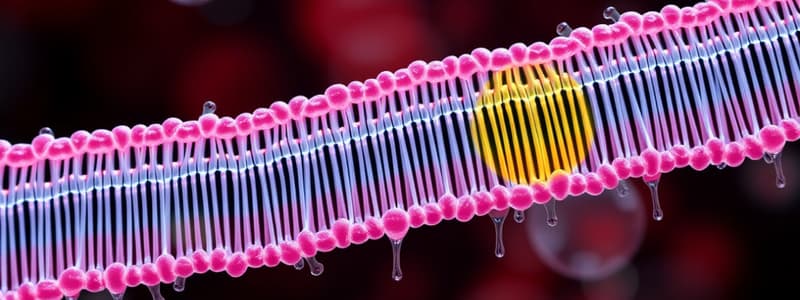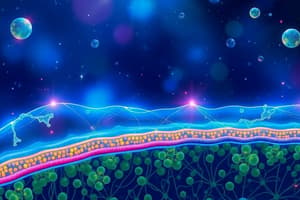Podcast
Questions and Answers
What does the Goldman equation calculate regarding cell membranes?
What does the Goldman equation calculate regarding cell membranes?
- Resting potential based solely on potassium concentration
- Membrane potential when three ions are present
- Membrane potential involving both positive and negative ions (correct)
- Membrane potential exclusively for positive ions
What is the value of the Nernst potential for potassium (K+)?
What is the value of the Nernst potential for potassium (K+)?
- -70
- -94 (correct)
- +61 mV
- +50 mV
During the initial phase of an action potential, what is the membrane potential changing from?
During the initial phase of an action potential, what is the membrane potential changing from?
- Equilibrium potential to resting potential
- Resting negative potential to positive potential (correct)
- Positive potential to resting stage
- Zero potential to negative potential
What characterizes the stages of an action potential?
What characterizes the stages of an action potential?
What is the resting membrane potential established by?
What is the resting membrane potential established by?
What happens to the membrane potential during an action potential?
What happens to the membrane potential during an action potential?
How does an action potential travel along the nerve fiber?
How does an action potential travel along the nerve fiber?
Which ions are primarily involved in establishing the resting membrane potential?
Which ions are primarily involved in establishing the resting membrane potential?
What provides the energy for the co-transport of glucose and sodium ions into the cell?
What provides the energy for the co-transport of glucose and sodium ions into the cell?
Which statement about the transport protein mentioned is true?
Which statement about the transport protein mentioned is true?
What type of transport mechanism is exemplified by the sodium co-transport of glucose and amino acids?
What type of transport mechanism is exemplified by the sodium co-transport of glucose and amino acids?
In what way does the membrane potential differ between extracellular fluid (ECF) and intracellular fluid (ICF)?
In what way does the membrane potential differ between extracellular fluid (ECF) and intracellular fluid (ICF)?
What occurs during endocytosis?
What occurs during endocytosis?
Which of the following best describes the state of sodium ions during the sodium co-transport process?
Which of the following best describes the state of sodium ions during the sodium co-transport process?
Which transport mechanism is described as the process of substances exiting the cell?
Which transport mechanism is described as the process of substances exiting the cell?
Which of the following pairs exemplifies what is being transported during sodium co-transport?
Which of the following pairs exemplifies what is being transported during sodium co-transport?
What role do voltage-gated potassium channels play during action potential?
What role do voltage-gated potassium channels play during action potential?
What happens to the membrane potential during depolarization?
What happens to the membrane potential during depolarization?
What combined effect speeds up the repolarization process?
What combined effect speeds up the repolarization process?
Which channels remain associated with the resting membrane potential?
Which channels remain associated with the resting membrane potential?
How quickly does the resting membrane potential recover after an action potential?
How quickly does the resting membrane potential recover after an action potential?
What opens the voltage-gated potassium channels?
What opens the voltage-gated potassium channels?
What is the primary function of the Na+-K+ pump during action potential?
What is the primary function of the Na+-K+ pump during action potential?
Which statement accurately describes the action potential process?
Which statement accurately describes the action potential process?
What is the conductance of potassium ions relative to sodium ions during the resting state?
What is the conductance of potassium ions relative to sodium ions during the resting state?
What state is the activation gate of the voltage-gated sodium channels in during the resting stage?
What state is the activation gate of the voltage-gated sodium channels in during the resting stage?
At what millivolts do the activation gates of the sodium channels open?
At what millivolts do the activation gates of the sodium channels open?
How soon do sodium channels begin to inactivate after opening during the action potential?
How soon do sodium channels begin to inactivate after opening during the action potential?
What initiates the voltage gating of potassium channels during the action potential?
What initiates the voltage gating of potassium channels during the action potential?
What factor contributes to the disparity in conductance between potassium and sodium ions during resting state?
What factor contributes to the disparity in conductance between potassium and sodium ions during resting state?
What is the significance of the action potential to threshold ratio for continued impulse propagation?
What is the significance of the action potential to threshold ratio for continued impulse propagation?
What occurs first at the onset of the action potential?
What occurs first at the onset of the action potential?
What effect does hypocalcemia have on sodium channels?
What effect does hypocalcemia have on sodium channels?
How much does sodium conductance increase at the onset of the action potential?
How much does sodium conductance increase at the onset of the action potential?
What leads to the initiation of the action potential in a resting nerve fiber?
What leads to the initiation of the action potential in a resting nerve fiber?
What phenomenon occurs as a result of spontaneous discharge in peripheral nerves?
What phenomenon occurs as a result of spontaneous discharge in peripheral nerves?
How do calcium channels differ from sodium channels in terms of gating?
How do calcium channels differ from sodium channels in terms of gating?
What is the role of a positive-feedback cycle in the context of action potentials?
What is the role of a positive-feedback cycle in the context of action potentials?
What happens to the membrane potential if many voltage-gated sodium channels open at once?
What happens to the membrane potential if many voltage-gated sodium channels open at once?
Which of the following describes the condition when sodium channels exhibit increased permeability?
Which of the following describes the condition when sodium channels exhibit increased permeability?
Flashcards are hidden until you start studying
Study Notes
Transport Mechanisms in Cells
- Active Transport: Movement of substances through a cell membrane, often against a concentration gradient.
- Secondary Active Transport (Co-Transport):
- Involves symport and antiport mechanisms to transport multiple substances.
- Example: Co-transport of glucose and amino acids with sodium ions.
- Requires sodium concentration gradient (high outside, low inside) to provide energy.
Sodium-Glucose Co-Transport
- Sodium and glucose bind to a transporter protein with two sites: one for sodium and one for glucose.
- Conformational change occurs only when both bind, allowing transport into the cell.
Vesicular Transport
- Endocytosis: Process of engulfing substances into the cell.
- Exocytosis: Process of expelling substances from the cell.
Membrane Potential
- Electrolyte Concentration:
- Extracellular fluid (ECF) has high sodium (Na+) and low potassium (K+).
- Intracellular fluid (ICF) has the opposite concentration of ions.
Goldman Equation
- Used to calculate membrane potential considering the permeability of specific ions: Na+, K+, and Cl−.
Action Potentials
- Rapid changes in membrane potential that propagate along nerve fibers.
- Initiate from resting membrane potential (-90 mV) to a positive peak and return to a negative state through depolarization and repolarization.
Stages of Action Potential
- Resting Stage: Membrane at -90 mV, potassium conductance is significantly higher than sodium.
- Depolarization: Rapid entry of sodium ions due to opening of voltage-gated sodium channels.
- Repolarization: Sodium channels inactivate and potassium channels open, restoring negative potential.
Voltage-Gated Channels
- Potassium Channels: Open slowly after sodium channels, contributing to repolarization by allowing potassium to exit.
- Calcium Channels: Slow channels; increase sodium channel permeability in response to low calcium levels, potentially leading to spontaneous nerve firing.
Safety Factor for Propagation
- The ratio of action potential to threshold must remain greater than 1 for continued impulse propagation along the nerve fiber.
Positive-Feedback Cycle in Action Potentials
- Initial disturbance raises membrane potential, prompting the opening of more sodium channels, leading to a rapid influx of sodium ions and an amplified membrane potential change.
Studying That Suits You
Use AI to generate personalized quizzes and flashcards to suit your learning preferences.



